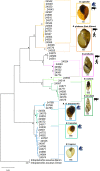Bulinus snails in the Lake Victoria Basin in Kenya: Systematics and their role as hosts for schistosomes
- PMID: 36763676
- PMCID: PMC9949660
- DOI: 10.1371/journal.pntd.0010752
Bulinus snails in the Lake Victoria Basin in Kenya: Systematics and their role as hosts for schistosomes
Abstract
The planorbid gastropod genus Bulinus consists of 38 species that vary in their ability to vector Schistosoma haematobium (the causative agent of human urogenital schistosomiasis), other Schistosoma species, and non-schistosome trematodes. Relying on sequence-based identifications of bulinids (partial cox1 and 16S) and Schistosoma (cox1 and ITS), we examined Bulinus species in the Lake Victoria Basin in Kenya for naturally acquired infections with Schistosoma species. We collected 6,133 bulinids from 11 sites between 2014-2021, 226 (3.7%) of which harbored Schistosoma infections. We found 4 Bulinus taxa from Lake Victoria (B. truncatus, B. tropicus, B. ugandae, and B. cf. transversalis), and an additional 4 from other habitats (B. globosus, B. productus, B. forskalii, and B. scalaris). S. haematobium infections were found in B. globosus and B. productus (with infections in the former predominating) whereas S. bovis infections were identified in B. globosus, B. productus, B. forskalii, and B. ugandae. No nuclear/mitochondrial discordance potentially indicative of S. haematobium/S. bovis hybridization was detected. We highlight the presence of Bulinus ugandae as a distinct lake-dwelling taxon closely related to B. globosus yet, unlike all other members of the B. africanus species group, is likely not a vector for S. haematobium, though it does exhibit susceptibility to S. bovis. Other lake-dwelling bulinids also lacked S. haematobium infections, supporting the possibility that they all lack compatibility with local S. haematobium, thereby preventing widespread transmission of urogenital schistosomiasis in the lake's waters. We support B. productus as a distinct species from B. nasutus, B. scalaris as distinct from B. forskalii, and add further evidence for a B. globosus species complex with three lineages represented in Kenya alone. This study serves as an essential prelude for investigating why these patterns in compatibility exist and whether the underlying biological mechanisms may be exploited for the purpose of limiting schistosome transmission.
Copyright: © 2023 Babbitt et al. This is an open access article distributed under the terms of the Creative Commons Attribution License, which permits unrestricted use, distribution, and reproduction in any medium, provided the original author and source are credited.
Conflict of interest statement
The authors declare no competing interests.
Figures




Similar articles
-
Transcriptional profiling of Bulinus globosus provides insights into immune gene families in snails supporting the transmission of urogenital schistosomiasis.Dev Comp Immunol. 2024 May;154:105150. doi: 10.1016/j.dci.2024.105150. Epub 2024 Feb 15. Dev Comp Immunol. 2024. PMID: 38367887 Free PMC article. Review.
-
Interactions between Schistosoma haematobium group species and their Bulinus spp. intermediate hosts along the Niger River Valley.Parasit Vectors. 2020 May 24;13(1):268. doi: 10.1186/s13071-020-04136-9. Parasit Vectors. 2020. PMID: 32448268 Free PMC article.
-
Transmission and diversity of Schistosoma haematobium and S. bovis and their freshwater intermediate snail hosts Bulinus globosus and B. nasutus in the Zanzibar Archipelago, United Republic of Tanzania.PLoS Negl Trop Dis. 2022 Jul 5;16(7):e0010585. doi: 10.1371/journal.pntd.0010585. eCollection 2022 Jul. PLoS Negl Trop Dis. 2022. PMID: 35788199 Free PMC article.
-
Molecular characterization and distribution of Schistosoma cercariae collected from naturally infected bulinid snails in northern and central Côte d'Ivoire.Parasit Vectors. 2019 Mar 19;12(1):117. doi: 10.1186/s13071-019-3381-3. Parasit Vectors. 2019. PMID: 30890180 Free PMC article.
-
Interactions between intermediate snail hosts of the genus Bulinus and schistosomes of the Schistosoma haematobium group.Parasitology. 2001;123 Suppl:S245-60. doi: 10.1017/s0031182001008046. Parasitology. 2001. PMID: 11769287 Review.
Cited by
-
One Health monitoring reveals invasive freshwater snail species, new records, and undescribed parasite diversity in Zimbabwe.Parasit Vectors. 2024 May 22;17(1):234. doi: 10.1186/s13071-024-06307-4. Parasit Vectors. 2024. PMID: 38773521 Free PMC article.
-
Nuclear Intron Sequence Variation of the Bulinus globosus Complex (Mollusca: Planorbidae): Implications for Molecular Systematic Analyses.Biology (Basel). 2025 Jan 10;14(1):53. doi: 10.3390/biology14010053. Biology (Basel). 2025. PMID: 39857284 Free PMC article.
-
Future climate and demographic changes will almost double the risk of schistosomiasis transmission in the Lake Victoria Basin.One Health. 2025 Jul 18;21:101148. doi: 10.1016/j.onehlt.2025.101148. eCollection 2025 Dec. One Health. 2025. PMID: 40735740 Free PMC article. Review.
-
An accident waiting to happen? Exposing the potential of urogenital schistosomiasis transmission in the Lake Albert region, Uganda.Parasit Vectors. 2023 Nov 3;16(1):398. doi: 10.1186/s13071-023-06017-3. Parasit Vectors. 2023. PMID: 37919743 Free PMC article.
-
Transcriptional profiling of Bulinus globosus provides insights into immune gene families in snails supporting the transmission of urogenital schistosomiasis.Dev Comp Immunol. 2024 May;154:105150. doi: 10.1016/j.dci.2024.105150. Epub 2024 Feb 15. Dev Comp Immunol. 2024. PMID: 38367887 Free PMC article. Review.
References
-
- Perlman SJ, Jaenike J. Infection success in novel hosts: an experimental and phylogenetic study of Drosophila-parasitic nematodes. Evolution. 2003;57: 544–557. - PubMed
-
- Vanhove MPM, Pariselle A, Van Steenberge M, Raeymaekers JAM, Hablützel PI, Gillardin C, et al.. Hidden biodiversity in an ancient lake: phylogenetic congruence between Lake Tanganyika tropheine cichlids and their monogenean flatworm parasites. Sci Rep. 2015;5: 13669. doi: 10.1038/srep13669 - DOI - PMC - PubMed
Publication types
MeSH terms
Grants and funding
LinkOut - more resources
Full Text Sources

